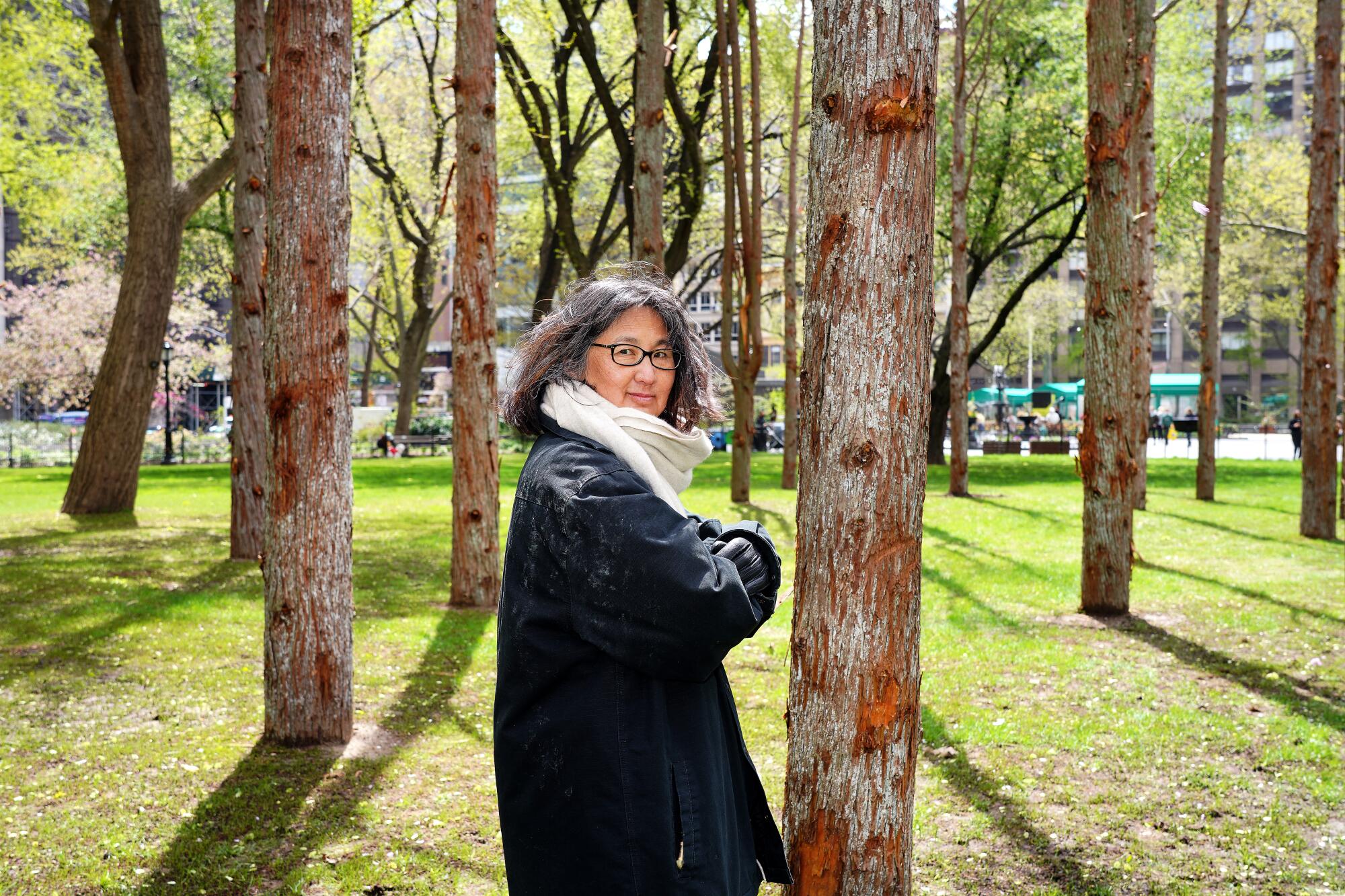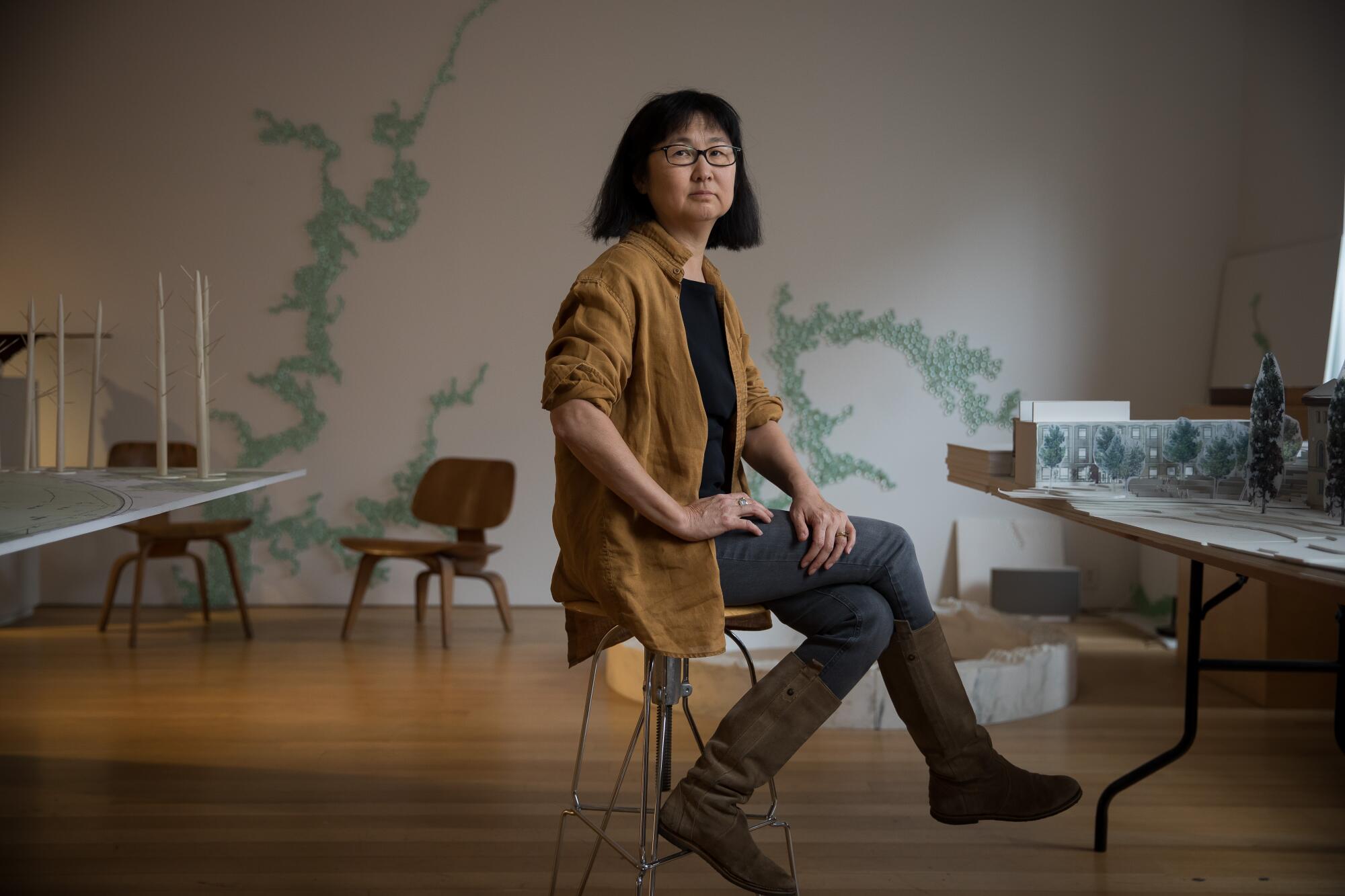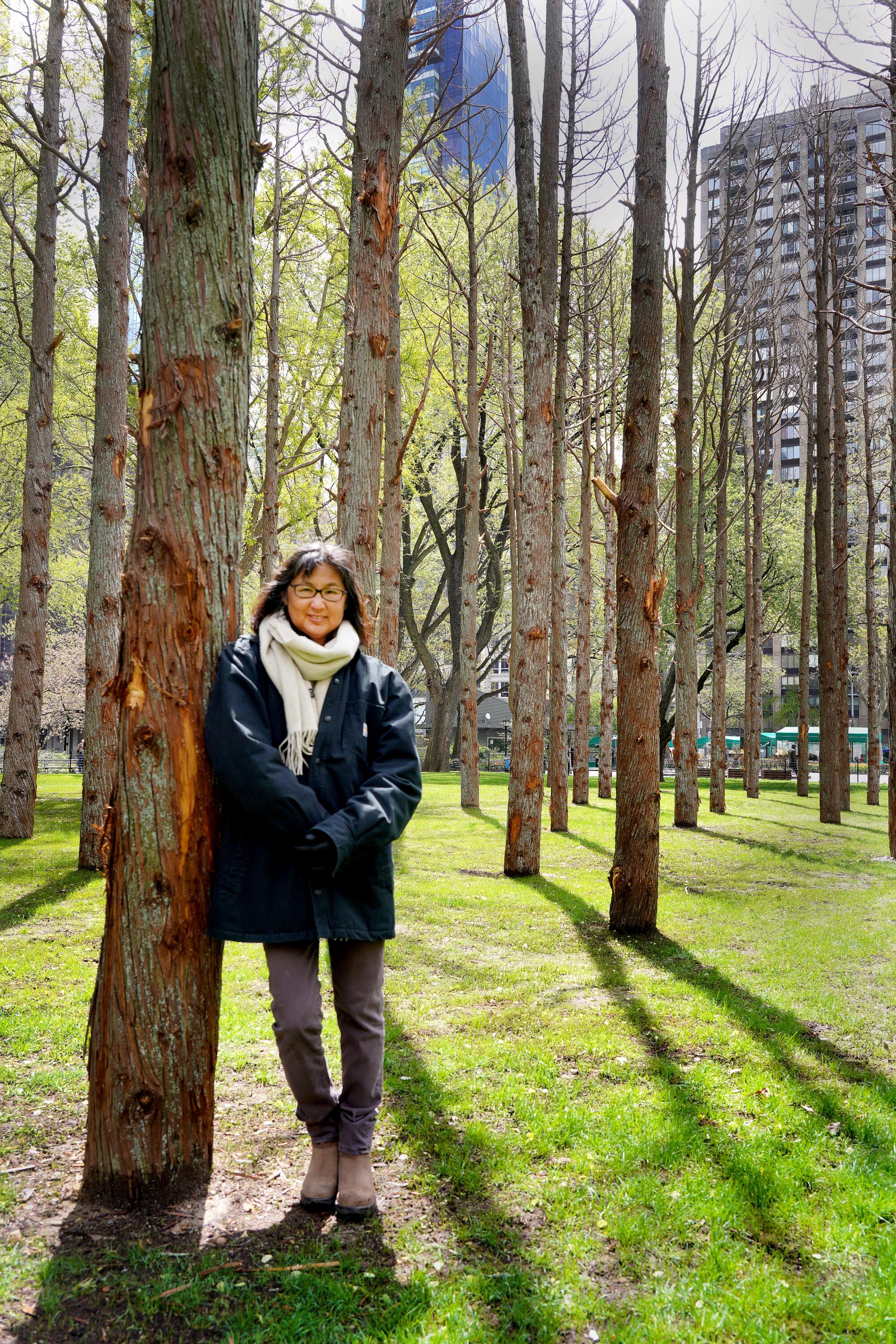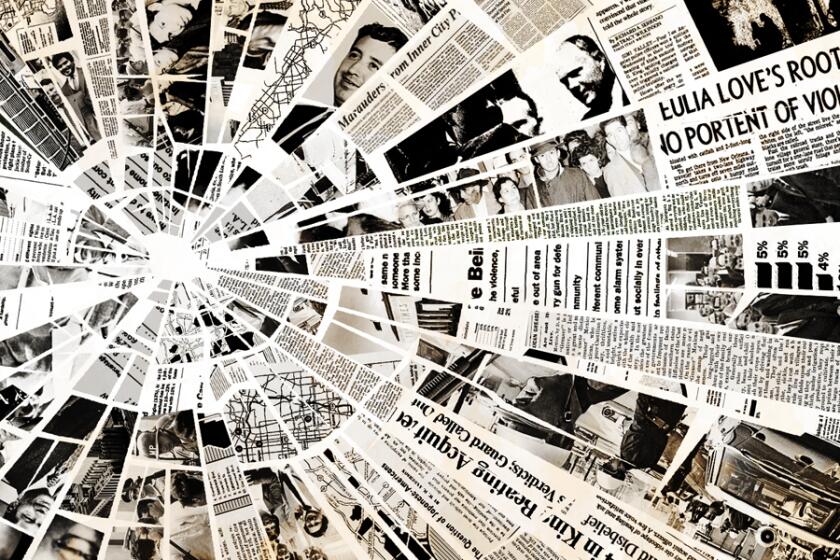
For more than a year, I’ve kept a folder on my desk that was stuffed full of scribbled notes for the story I was working on when the pandemic hit. Every journalist, it seems, has a version of this folder — ideas rendered moot by the arrival of our global calamity.
The story, about the architecture of libraries, was also a story about how women design for women. The library in question was one I knew intimately: Neilson Library, the central library at Smith College, the women’s college in Northampton, Mass., where I studied as an undergraduate.
My focus was a $120-million renovation of that space designed by Maya Lin Studio, in collaboration with Boston-based firm Shepley Bulfinch, which had devised Neilson’s master plan.
Shepley has a deep know-how in academic design, including plenty of libraries. And Maya Lin Studio, of course, is run by the celebrated designer behind the groundbreaking Vietnam Veterans Memorial in Washington, D.C., as well as the intimate Langston Hughes Library in Tennessee. Lin is also someone with a profound emotional connection to Smith College: Her mother, Julia Ming Hui Chang Lin, landed at Smith in 1949 after escaping the Communist invasion of Shanghai on a fishing boat‚ her Smith acceptance letter and two $10 bills sewn into her dress.
In late February 2020, as the novel coronavirus was creeping into the U.S., I visited Lin at her studio, a comfortably worn loft space in downtown Manhattan. She described how much Smith had meant to her and her mother.
“Smith saved her life,” she said. “If it wasn’t for that, I wouldn’t exist.”
What began as a story about a building, however, ultimately became about how so much can change in the course of one fateful year.
On that crisp February morning in which we met last year, Lin said something that later rattled around my brain for weeks.
At the time, she also was working on an art installation titled “Ghost Forest” that would place a grove of towering Atlantic cedars — all dead — in the middle of Manhattan’s Madison Square Park. The piece was intended to draw attention to the plight of a native tree that has been decimated by habitat loss, the presence of invasive species and, now, climate change.
“We cannot continue on this path,” Lin stated firmly as she described the urgent need to work collectively to mitigate the effects of climate change.
Three weeks later, the World Health Organization declared the COVID-19 outbreak a pandemic — and our ability to work collectively was put to rigorous test.
In the 14 months since I first began reporting this story, there has been illness and isolation and death — tolls so great they only register as abstractions: 577,000 dead in the U.S. and more than 3.2 million globally. In that same period, there also have been a wave of seismic societal shifts as the pandemic’s inequitable tolls, combined with the uprisings for Black lives, force us to reckon with systemic disenfranchisement.
Like every other institution that wasn’t Wall Street, Smith College was battered by the pandemic. The college faced a $35 million shortfall in its 2020-21 budget. In response, Smith increased its endowment draw, the senior leadership team took voluntary pay cuts and more than 200 staff members were furloughed. (All but one have since returned.)
Though the library was being paid for out of a separate capital budget and had been financed, in part, by almost $43 million in private philanthropy, the toll the pandemic took on the school’s workers made a high-profile construction project feel ill-timed. (Full disclosure: I served on Smith’s alumni association board for three years in the aughts and spent another three years on an alumni committee that helped support the libraries by raising funds for author lectures and digitization efforts. I had no role, decision-making or otherwise, in the renovation plans.)
In addition, the college found itself in the crucible of the cancel-culture wars this winter after the public resignation of a librarian who alleged a “racially hostile environment” toward white people, and the resurfacing of a 2018 incident in which a Black student alleged discrimination after being questioned by a campus police officer while eating in a dorm area. (A later inquiry found that the area had been closed to Smith students and faculty for the summer and that this may have motivated the initial call.)
Smith’s situation is hardly unique. At The Times, the pandemic’s economic crunch resulted in layoffs and furloughs. We too have contended with reckonings over our legacy as an institution, both to the communities we serve and our own staff. (We published a package of stories about it last fall.)
As the country grapples with the role of systemic racism, The Times has committed to examining its past.
Lin, meanwhile, was grappling with the rising tide of hate directed at Asian Americans during the pandemic.
“I was in the subway in February of last year and I sneezed and the entire subway car moved away from me,” she told me in a telephone interview last month. “I started hearing from friends of mine who are Asian how they were being accosted. ... I had a friend who was asked to leave a restaurant. I’ve had friends in New York spat upon and called horrible names.”
“Before, it was spoken of but not publicly written about,” she said. “It’s good that it’s finally being written about.”
Moreover, earlier this year, in a cruel twist of fate, Lin’s husband of nearly 25 years, Daniel Wolf, died of a sudden heart attack. Wolf was an art dealer who specialized in photography and helped the Getty Museum amass its enviable collection of more than 25,000 images.
He died in late January. Two months later, Lin was in Northampton for the library’s unveiling at Smith.
“In normal circumstances it would have been wonderful,” she said. “It’s hard for me right now.”

For a time, I wondered if there would ever be a good time to write the story I had carried with me for more than a year. But as I combed through my notes, I realized how urgent some of its themes remained.
Early last fall, Southern California had its worst fire season ever. The air around Los Angeles grew so thick with smoke it was impossible to see the sun; the daylight that did manage to penetrate it was sallow and wan. During the worst of it, my husband and I, along with our 65-pound dog, lived, worked, slept and ate in our home office — the only air-conditioned room in the house. My pandemic weariness turned into despondence.
When I think of those days, I think of Lin’s “Ghost Forest.” In California, we are surrounded by ghost forests.
“The West will suffer in one way but the East suffers in another — with water,” Lin said. “The people who tell you climate change is a myth? Well, we’re in it.”
The installation of “Ghost Forest” was postponed for a year due to COVID-19 but finally opens to the public on Monday. It will include a soundscape, accessible via smartphone, that features the calls and songs of animals that once were common to the island of Manhattan, as well as a planting project that will place 1,000 native trees and shrubs in parks around New York City.
“I didn’t just want this to be about loss,” Lin explained. “Our first public program will focus on nature-based solutions to climate change.”
The project is part of Lin’s long-running interest in ecological themes. For more than a decade, she has tracked the disappearance of plants and animals from specific landscapes through the multimedia online project “What Is Missing?” — which she is in the middle of redesigning.
Lin has regularly stated that “What Is Missing?” will be her “last memorial.” And currently, she has no plans to design any memorial related to the pandemic. Still, she does consider the questions it would raise.

“For the memory works, I ask, what are the lessons we need to learn from history so that something like this doesn’t happen again?”
But at a moment in which variants are tearing through India, and the dead have yet to be fully counted, we still find ourselves struggling against forces of nature that defy comprehension. In that regard, said Lin, the pandemic and climate change are kindred disasters.
“It’s a wake-up call,” she said. “We have a lot of work to do. No one can be an isolationist. You can’t save yourself from a global pandemic if you don’t learn to cooperate.”
If “Ghost Forest” touches on our critical climate moment, the Neilson Library project raises issues of representation that have become even more pressing over the last year.
The library’s special collections include extensive original materials related to gender equality, reproductive rights and other social justice movements, and it holds personal papers connected with figures such as Gloria Steinem, Marian Anderson and Sylvia Plath.
Neilson also represents something unique: a building designed by women for a client team of women for a public that would consist principally of women. It is architecture that quite literally centers women’s knowledge at a time in which women remain underrepresented in the field. An estimated 20% of licensed architects are women, despite the fact that they represent half of all architecture degrees earned.
In addition to Lin, who leads her own small, namesake studio, Shepley Bulfinch, which served as executive architects on the project, is a majority woman-owned firm.
“I’d never been to a groundbreaking where everyone was a woman,” Smith College President Kathleen McCartney told me during a visit to campus early last year. “It was six women with shovels.”
The result is a library that was more adaptable to 21st century needs and more cognizant of women both as scholars and subjects of scholarship.
The original Neilson, completed in 1909, had been designed in a somber Renaissance Revival style by the New York-based Lord & Hewlett. But any grandeur the building had once possessed was pretty much frittered away by a pair of unsympathetic brick wings that were added in the 1960s and ’80s — the architectural equivalent of throwing a beige trench coat over an evening dress. These not only had the effect of transforming the building into a wall that split the campus in two but they turned the interior spaces into a dreary warren of corridors.
In addition, at a time in which learning is an increasingly collaborative process that requires a range of flexible spaces for gatherings and research, the additions contained load-bearing stacks that could neither be moved nor rearranged. The old architecture was unable to adapt.
Lin tore down the graceless expansions, preserving only the shell of the original Lord & Hewlett building. A new floor plan was inserted and two gently curving wings swaddled in limestone — known informally as “jewel boxes” — were added to the northern and southern ends of the building.
Generous windows and an oculus draw light into the depths of the wings, which feature a range of flexible study and gathering spaces. In addition, the wings occupy a smaller footprint than the additions they replaced, returning some of the landscape back to the campus.
“The tendency might be to take it all down, to make it all new,” said Lin as she walked me through a maquette of the building in her studio last year. “But the emotional history is hugely important.”
That history includes her mother. A sunken garden adjacent to the northern jewel box is named for Julia Chang Lin, a graduate of Smith’s class of 1951, and an important poet and scholar of literature who helped draw attention to poetry by Chinese women in the West.
In the old library, Smith’s special collections had been buried amid the tangle of corridors. Lin’s concept put them in an airy and prominent space in one of the jewel boxes.
“That is an intentional strategic initiative for us,” said Smith dean of libraries Susan Fliss. “To bring more focus and relevance to the experience of these women.”
In recent years, the college has worked to diversify these archives. Smith now holds papers connected with Latina reproductive rights activist Luz Alvarez Martinez, Mohawk midwife and environmentalist Katsi Cook and Byllye Avery, founder of the National Black Women’s Health Project.
Lin and the team at Shepley Bulfinch — Janette S. Blackburn was the principal in charge of the Smith project — are not the first women to design buildings on the Smith campus. Susan T. Rodriguez, who was then a design partner at Polshek Partnership (now known as Ennead), led the design on the campus’ Brown Fine Arts Center, and Marion Weiss, of Weiss/Manfredi (the firm that will soon make over Los Angeles’ La Brea Tar Pits site), helped design Smith’s 60,000-square-foot student center in 2003.
And certainly, other female architects have worked on designs for other women’s colleges. In California, Julia Morgan famously helped design some of the buildings at Mills College in the early 20th century — including the library and El Campanil, the school’s iconic Mission Revival clock tower.
When critic Esther McCoy was given the Julia Morgan Award in 1987, she wondered if women architects brought with them a different understanding of how people use space.
“Men may see people moving in space, but women can see them more easily talking in space, grouping up,” she said in her acceptance speech.
Certainly, it would be reductive to say that women design in any particular way because they are women.
“I design for people,” Lin told me last year. “I don’t think I design for women different than men.”
But there is something about designing a purpose-built structure for women that raises questions about who serves as the default in architecture.
There is scale, for one, since women generally are smaller than men, yet most public buildings are designed with male defaults in mind. As someone who is 5-foot-3-inches tall and has spent a lifetime standing on tiptoes to reach surfaces and sitting in chairs where my feet dangle, I feel this intensely. And don’t get me started on frosty office environments geared to the metabolic rates of men.
“The other thing that I think is really important is understanding the security aspects,” Blackburn said via telephone last month. “Not just physical security — whether it’s women or men. But a sensibility called prospect and refuge — so, wanting to sit where people aren’t coming at your back, so that you can see the space in front of you. In a nuanced way, it may be a little more important in terms of how women perceive space.
“It’s not,” she added, “about certain colors.”
Lin said her aim was to design a library that was “open and had daylight and was warm and inviting” — which is likely to be the most resonant aspect of the building. After a year from which we have emerged lonely and weary, Neilson Library may just be the right architecture at the right time.
In a telephone conversation last month, Smith College President McCartney said she hoped the new library would offer sanctuary. “For [Maya], libraries were today’s temples,” she says. “They feel like sacred spaces. I just love thinking about libraries that way, especially as an academic.”
Emma Solis, a sophomore from San Antonio who returned to the Smith campus in the spring, said the library has been generally well received by the student body — especially after so much isolation.
“People were really cooped up in their rooms, either out of fear or because they didn’t have spaces to go,” she said.
The library has given them that space. “I like how you can see people,” Solis added. “Maybe that sounds weird, but in quarantine times, it feels great to see people existing.”
And certainly, it helps when those spaces embrace their inhabitants in singular ways.
“I think aesthetics feel more important than ever,” said McCartney. “Beautiful spaces can transport you. And good architecture can do that too.”
Anne Lacaton and Jean-Philippe Vassal take architecture’s top honor for work that includes the Palais de Tokyo rehab and social housing preservation
Lin may no longer be designing literal monuments but perhaps her library contains within it a monument’s properties. After all, the purpose of a monument is to consider the lessons of history. They also serve to heal.
In the 14 months since I started this story, life has gotten smaller, more hermetic; millions have died and politicians around the world have challenged the nature of truth for personal gain. The Neilson Library, however, offers a site to delve into our shared knowledge and renew our sense of the collective. That’s no small thing.
Our future depends on it.
More to Read
The biggest entertainment stories
Get our big stories about Hollywood, film, television, music, arts, culture and more right in your inbox as soon as they publish.
You may occasionally receive promotional content from the Los Angeles Times.












